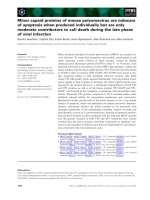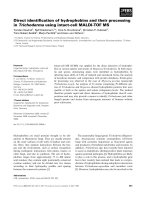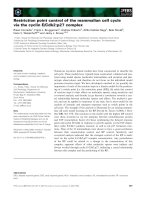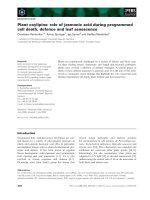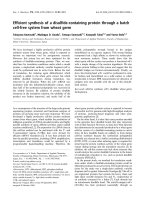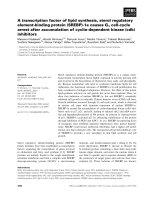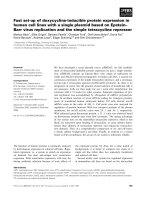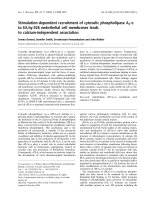Báo cáo khoa học: "Mantle cell lymphoma of the gastrointestinal tract presenting with multiple intussusceptions – case report and review of literature" docx
Bạn đang xem bản rút gọn của tài liệu. Xem và tải ngay bản đầy đủ của tài liệu tại đây (2.15 MB, 6 trang )
BioMed Central
Page 1 of 6
(page number not for citation purposes)
World Journal of Surgical Oncology
Open Access
Case report
Mantle cell lymphoma of the gastrointestinal tract presenting with
multiple intussusceptions – case report and review of literature
Venkata KN Kella*
1
, Radu Constantine
2
, Nalini S Parikh
2
, Mary Reed
1
,
John M Cosgrove
1
, Stephen M Abo
2
and Saundra King*
1
Address:
1
Department of Surgery and Oncology, Bronx-Lebanon Hospital Center, Bronx, New York, USA and
2
Department of Surgery, Pathology
and Medical Oncology, Saint Michaels Medical Center, Newark, New Jersey, USA
Email: Venkata KN Kella* - ; Radu Constantine - ; Nalini S Parikh - ;
Mary Reed - ; John M Cosgrove - ; Stephen M Abo - ;
Saundra King* -
* Corresponding authors
Abstract
Background: Mantle cell lymphoma (MCL) is an aggressive type of B-cell non-Hodgkin's
lymphoma that originates from small to medium sized lymphocytes located in the mantle zone of
the lymph node. Extra nodal involvement is present in the majority of cases, with a peculiar
tendency to invade the gastro-intestinal tract in the form of multiple lymphomatous polyposis. MCL
can be accurately diagnosed with the use of the highly specific marker Cyclin D1. Few cases of
mantle cell lymphoma presenting with intussuception have been reported. Here we present a rare
case of multiple intussusceptions caused by mantle cell lymphoma and review the literature of this
disease.
Case presentation: A 68-year-old male presented with pain, tenderness in the right lower
abdomen, associated with nausea and non-bilious vomiting. CT scan of abdomen revealed ileo-colic
intussusception. Laparoscopy confirmed multiple intussusceptions involving ileo-colic and ileo-ileal
segments of gastrointestinal tract. A laparoscopically assisted right hemicolectomy and extended
ileal resection was performed. Postoperative recovery was uneventful. The histology and immuno-
histochemistry of the excised small and large bowel revealed mantle cell lymphoma with multiple
lymphomatous polyposis and positivity to Cyclin D1 marker. The patient was successfully treated
with Rituximab-CHOP chemotherapy and remains in complete remission at one-year follow-up.
Conclusion: This is a rare case of intestinal lymphomatous polyposis due to mantle cell lymphoma
presenting with multiple small bowel intussusceptions. Our case highlights laparoscopic-assisted
bowel resection as a potential and feasible option in the multi-disciplinary treatment of mantle cell
lymphoma.
Background
Approximately 6% of lymphomas are classified as mantle
cell lymphomas (MCL) [1,2]. MCL generally occurs in
adults with a median age of 60 and a male predominance.
Advanced disease with involvement of regional lymph
nodes, liver, spleen, or peripheral blood is common at
presentation. More than 50% of patients with MCL have
bone marrow involvement at the time of diagnosis. The
Published: 31 July 2009
World Journal of Surgical Oncology 2009, 7:60 doi:10.1186/1477-7819-7-60
Received: 21 April 2009
Accepted: 31 July 2009
This article is available from: />© 2009 Kella et al; licensee BioMed Central Ltd.
This is an Open Access article distributed under the terms of the Creative Commons Attribution License ( />),
which permits unrestricted use, distribution, and reproduction in any medium, provided the original work is properly cited.
World Journal of Surgical Oncology 2009, 7:60 />Page 2 of 6
(page number not for citation purposes)
primary presentation of extra nodal disease occurs in one
quarter of patients and frequently involves Waldeyer's
ring and the gastrointestinal tract. Multiple lymphoma-
tous polyposis (MLP) is one of the most common primary
gastrointestinal presentations of MCL and accounts for
approximately about 9% of primary gastrointestinal lym-
phomas [3].
MLP most commonly occurs in the ascending colon and
the small bowel, particularly in the ileum and ileocecal
region. Occasionally, however, numerous polyps are
present throughout the entire gastrointestinal tract. Pol-
yps may be sessile, polypoid or both. They range in size
from 0.1 to 4–5 cm and present with ulceration.
Intussusception occurs when a proximal segment of
bowel (intussusceptum) telescopes into the lumen of an
adjacent distal segment (intussuscipiens) and can occur
anywhere within the gastrointestinal tract. Although fairly
common in children, adult intussusception is relatively
rare representing only 1% of patients with bowel obstruc-
tions [4,5]. We present a case of multiple lymphomaotous
polyposis due to mantle cell lymphoma presenting with
multiple intussusceptions.
Case presentation
A 68-year-old previously healthy male presented with four
days of constant pain in the right lower abdomen, associ-
ated with nausea and vomiting. There was no history of
fever or weight loss. Physical examination revealed nor-
mal vital signs, a soft distended abdomen with hyperac-
tive bowel sounds, and a palpable tender mass in the right
lower quadrant. Digital rectal examination revealed hem-
orrhoids and guaiac positive stool. Laboratory evaluation
was notable for low hematocrit (31%) and albumin (2.6
g/dL) levels. A plain abdominal radiograph showed a
nonspecific gas pattern in the bowel with fecal loading of
the descending and sigmoid colon.
A CT-scan of the abdomen with contrast showed ileo-colic
intussusception (Fig 1). At laparoscopy, ileocecal intus-
susception and two more ileo-ileal intussusceptions were
found along with multiple tumors involving the entire
length of jejunum, ileum and ascending colon (Figures 2,
3, 4).
The patient underwent a laparoscopically-assisted right
hemicolectomy, with extended ileal resection and a sta-
pled ileo-colic anastomosis. The postoperative period was
uneventful and the patient was discharged on the fourth
postoperative day.
The pathology confirmed multiple lesions of about one
inch diameter, involving the small bowel, cecum, and
asceding colon (Fig 5). Histology revealed a malignant B-
cell lymphoma. Immuno histochemistry and immu-
nophenotypic analyses were positive for Cyclin D1 (Fig
6), CD20 (Fig 7), CD5 (Fig 8) and CD 79a (Fig 9), but
negative for BCL6, CD23 and CD10, thus confirming the
diagnosis of mantle cell lymphoma (Fig 10).
Upon hospital discharge, the patient underwent staging
investigations with negative bone marrow involvement.
He received 6 out of 8 planned cycles of chemotherapy
with rituximab-CHOP (cyclophosphamide, doxorubicin,
vincristine, prednisone) with moderate to severe toxicity
in form of fatigue, febrile neutropenia despite growth fac-
tors and dose reduction, and failure to thrive. Restaging
with PET CT confirmed complete response with no resid-
CT scan of abdomen showing ileo-colic intussusceptionFigure 1
CT scan of abdomen showing ileo-colic intussuscep-
tion.
Intraoperative pictures showing multiple (three) intussuscep-tions (part 1)Figure 2
Intraoperative pictures showing multiple (three)
intussusceptions (part 1).
World Journal of Surgical Oncology 2009, 7:60 />Page 3 of 6
(page number not for citation purposes)
ual disease. At one year follow-up, he remains in remis-
sion with a good performance status.
Discussion
The term "multiple lymphomatous polyposis" was first
presented by Cornes in 1961 to describe numerous poly-
poid lesions throughout the entire GI tract consisting of
mucosal involvement by malignant lymphoma [3]. In
1980, Blackshaw classified MLP as B-cell centrocytic non-
Hodgkin's lymphoma according to the Kiel classification
[6,7] According to the Working Formulation; MLP is clas-
sified as a diffuse, small-cleaved cell malignant lym-
phoma [8]. Isaacson et al. [9] and Triozzi et al. [10] have
suggested that MLP is the digestive counterpart of mantle
zone lymphoma that arises in lymph nodes. Following
further immunohistochemical and cytogenetic study,
MLP has been confrmed to be a mantle cell lymphoma
involving the gastrointestinal tract [10].
MLP can present with symptoms such as abdominal pain,
diarrhea, bleeding, and less frequently, protein-losing
enteropathy, intestinal malabsorption, or chylous ascites.
Rarely, MLP presents as an acute abdomen due to perfora-
tion or intestinal obstruction. MLP polyps usually occur in
the ileocecal region and in one third of cases present as a
mass [11,12]. Upper gastrointestinal endoscopy, enteros-
copy and colonoscopy are important tools in diagnosing
MLP to assess the locations of the polyps and obtain tissue
biopsies. Differentiating lymphomatous polyposis from
Intraoperative pictures showing multiple (three) intussuscep-tions (part 2)Figure 3
Intraoperative pictures showing multiple (three)
intussusceptions (part 2).
Intraoperative pictures showing multiple (three) intussuscep-tions (part 3)Figure 4
Intraoperative pictures showing multiple (three)
intussusceptions (part 3).
Excised specimen showing numerous intraluminal and serosal lymphomatous polyposisFigure 5
Excised specimen showing numerous intraluminal
and serosal lymphomatous polyposis.
Immunohistochemistry of the polypoid lesion revealing strong positivity with Cyclin D1Figure 6
Immunohistochemistry of the polypoid lesion reveal-
ing strong positivity with Cyclin D1.
World Journal of Surgical Oncology 2009, 7:60 />Page 4 of 6
(page number not for citation purposes)
adenomatous or hamartomatous polyposis by endo-
scopic or radiological evaluation alone is impossible and
tissue diagnosis is required. Additionally, not all lympho-
matous polyposis of the gastrointestinal tract result from
MCL. Michopulos et al, showed that only 12 out of 35
cases of lymphomatous polyposis were MCL [13]. Follic-
ular lymphoma and MALT lymphoma can also present
with MLP.
Definitive diagnosis of MLP requires histological exami-
nation of the specimen with histomorphologic and
immunophenotypic analysis. In our case, histological
examination of the ileum, colon, mesenteric mass, and
lymph nodes showed malignant B-cell non-Hodgkin's
lymphoma. The histo morphology and the immunophe-
notypic analysis were consistent with a mantle cell lym-
phoma – positive for Cyclin D1, CD20, CD79a and CD5;
negative for BCL16, CD23 and CD10. These immunomar-
kers are essential in distinguishing mantle cell from other
types of lymphoma. See table 1[14].
Additionally, cytogenetic analysis of MCL shows rear-
rangement of the bcl-1 locus on chromosome11 due to t
(11:14) (q13:q32) translocation, accompanied by cyclin
D1 antigen overexpression [15].
Immunohistochemical stain with CD 20 showing strong posi-tivityFigure 7
Immunohistochemical stain with CD 20 showing
strong positivity.
Immuno histochemical stain with CD5 showing strong reac-tivityFigure 8
Immuno histochemical stain with CD5 showing
strong reactivity.
Immuno histochemical stain with CD79a showing strong positivityFigure 9
Immuno histochemical stain with CD79a showing
strong positivity.
Cytological appearance of mantle cell lymphoma High power fieldFigure 10
Cytological appearance of mantle cell lymphoma
High power field. The tumor is composed of small to
medium sized lymphocytes.
World Journal of Surgical Oncology 2009, 7:60 />Page 5 of 6
(page number not for citation purposes)
Surgery is the mainstay of therapy for intussusception in
adult patients. Increasingly, laparoscopy is replacing open
operations as the preferred approach. Diagnostic laparos-
copy may assist in the diagnosis of intussusception in
cases where diagnosis is suspected but not confirmed by
preoperative workup [16]. If the diagnosis is confirmed,
then appropriate surgical therapy and resection can be
performed depending on the comfort level of the surgeon.
Laparoscopy may aid in planning the incision if a laparo-
scopic-assisted or even laparotomy incision is required.
MCLs usually respond poorly to conventional therapeutic
regimens and are associated with short median survival.
Current combinations of monoclonal antibodies and
multi-agent chemotherapy have achieved significant
improvement in MCL response rates. Overall response
rates range from 80% to 95% and complete response rates
of 30% to 50% are frequently being achieved [17]. The R-
CHOP regimen was chosen due to the patient's poor per-
formance status at the time of diagnosis. Our patient only
received 6 out of 8 planned cycles of R-CHOP due to tox-
icity. Other chemotherapy regimens such as R-Hyper-
CVAD (Rituxan with hyperfractionated cyclophospha-
mide, vincristine, doxorubicin, and dexamethasone alter-
nating with high-dose methotrexate and cytarabine) have
shown good results in uncontrolled trials. However, it is a
more aggressive regimen associated with increased toxic-
ity. Despite the improved high response rate, current over-
all survival rates remain poor because of the early relapse.
Median survival with standard treatment for MCL patients
remains between 3 and 4 years [18]. Intensive immuno-
chemotherapy both with and without stem cell support
has been successfully used to prolong the progression-free
survival to 5 or more years [19,20]. These approaches
along with other innovative strategies utilizing bortezem-
bin [21], temsirolimus [22] or radioimmuno conjugates
for the relapsed or refractory setting remain under active
investigation.
To our knowledge, this is the first reported case of MCL
presenting with multiple intussusceptions of gastrointes-
tinal tract, separately involving the ileo colic and ileo-ileal
segments. Our case highlights laparoscopic-assisted bowel
resection as a potential and feasible option in the multi-
disciplinary treatment of mantle cell lymphoma, when
intussusception from MLP occurs.
Abbreviations
MCL: Mantle cell lymphoma; MLP: Multiple lymphoma-
tous polyposis;
Consent
Written informed consent was obtained from the patient
for publication of this case report and accompanying
images. A copy of the written consent is available for
review by the Editor-in-Chief of this journal
Competing interests
The authors declare that they have no competing interests.
Authors' contributions
VK, wrote the manuscript and involved in the patient care,
RC performed the surgery, NP reviewed the histology and
contributed to manuscript, SA involved with chemother-
apy and contributed to revision of manuscript, MR, JC
Critical review of manuscript. All authors read and
approved the manuscript.
Acknowledgements
Disclosure of funding from NIH, Welcome Trust, Howard Hughes Medical
Institute
References
1. Campos E, Raffeld M, Jaffe ES: Mantle cell lymphoma. Semin
Hematology 1999, 36:115-122.
2. Harris NL, Jaffe ES, Stein H, et al.: Perspective: a revised Euro-
pean-American classification of lymphoid neoplasms. A pro-
posal from the international lymphoma study group. Blood
1994, 84:1361-1392.
3. Cornes JS: Multiple lymphomatous polyposis of the gastroin-
testinal tract. Cancer 1961, 14:249-257.
Table 1: Phenotypic markers and chromosomal translocations in common B-cell lymphomas.
S Ig CD5 CD10 CD20 Other BCL2 Cyclin D1 K aryotype Oncogene Function
B-CLL/SLL Weak + - Weak CD23+ FMC7- - Deltion Trisomy
Follicular ++ - + + + + - t (14;18) BCL2 Antiapoptosis
Mantle cell ++ + - + FMC7+ + ++ t (11;14) Cyclin D1 Cell cycle
regulator
Marginal Zone + - - + CD11c+/- - No consistant anomaly
Nodal Marginal zone + - - + CD11 c+/- - t (11;18) AP12/MALT1 Antiapoptosis
MALT large cell + - - + +/- - t (1;14) t(3;14); t(3;v) BCL10 Antiapoptosis
BCL 6/BCL2 Transcription
Factor
Burkitt + - +/- + TdT- - - t (8;14)
t(2,8)
t (8;22)
CMYC Transcription factor
Publish with BioMed Central and every
scientist can read your work free of charge
"BioMed Central will be the most significant development for
disseminating the results of biomedical research in our lifetime."
Sir Paul Nurse, Cancer Research UK
Your research papers will be:
available free of charge to the entire biomedical community
peer reviewed and published immediately upon acceptance
cited in PubMed and archived on PubMed Central
yours — you keep the copyright
Submit your manuscript here:
/>BioMedcentral
World Journal of Surgical Oncology 2009, 7:60 />Page 6 of 6
(page number not for citation purposes)
4. Laws HL, Aldrete JS: Small-bowel obstruction: a review of 465
cases. South Med J 1976, 69(6):733-4.
5. Stewardson RH, Bombeck CT, Nyhus LM: Critical operative man-
agement of small bowel obstruction. Ann Surg 1978,
187(2):189-93.
6. Blackshaw AJ: Non-Hodgkin's lymphomas of the gut. In "Recent
Advances in Gastrointestinal Pathology" Edited by: Wright R. Eastbourne,
UK: WB Saunders; 1980:213-240.
7. Stansfeld AG, Diebold J, Kapanci Y, et al.: Updated Kiel classifica-
tion for lymphomas. Lancet 1988, 1:292-293.
8. The Non-Hodgkin's Lymphoma PathologicClassification Project:
National Cancer Institute sponsored study ofclassifications
onNon-Hodgkin's lymphomas:Summary and description of a
working formulation for clinical usage. Cancer 1982,
49:2112-2135.
9. Isaacson PG, MacLennan KA, Subbuswamy SG: Multiple lymphom-
atouspolyposis of the gastrointestinal tract. Histopathology
1984, 8:641-656.
10. Triozzi PL, Borowitz MJ, Gockerman JP: Gastrointestinal involve-
mentand multiple lymphomatous polyposis in mantle zone
lymphoma. J Clin Oncol 1986, 4:866-873.
11. Ruskone-Fourmestraux A, Delmer A, Lavargne A, et al.: Multiple
lymphomatous polyposis of the gastrointestinal tract: a pro-
spective clinico pathologic study of 31 cases. Gastroenterology
1997, 112:7-16.
12. Kauh J, Baidas SM, Ozdemirli M, et al.: Mantle cell lymphoma: clin-
icopathologic features and treatments. Oncology 2003,
17:879-891.
13. Michopoulus S, Petraki K, Matsouka C, et al.: Mantle-cell lym-
phoma (multiple lymphomatous polyposis) of the entire GI
tract. Clinical Oncology 2008, 20:1555-1557.
14. American society of hematology self-assessment program
ASH-tm-SAP text book.
3rd edition. 2007.
15. Li JY, Gaillard F, Moreau A, et al.: Detection of translocation
t(11:14) (q13:q32) in Mantle cell lymphoma by fluorescence
in situ hydrolization. Am J Pathol 1999, 154:1449-1452.
16. Laparoscopic-assistec small bowel resection for treatment
of adult small bowel intussusception: a case report. Cases J
2008, 1(1):432.
17. Witzig , Thomas E: Current Treatment Approaches for Mantle
Cell Lymphoma. J Clin Oncol 2005, 23:6409-6414.
18. Lenz G, Dreyling M, Hiddeman W: Mantle Cell Lymphoma.
Established therapeutic options and future directions. ANN
Hematol 2004, 83:71-77.
19. Geisler , Christian H, et al.: Long-term progression-free survival
of mantle cell lymphoma after intensive front-line immuno-
chemotherapy with in vivo-purged stem cell rescue: anon-
randomized phase 2 multicenter study by Nordic
Lymphoma Group. Blood 2008, 112:2687-2693.
20. Romaguera JE, et al.: High rate of durable remission after treat-
ment of newly diagnosed aggressive mantle-cell lymphoma
with rituximab plus hyper-CVAD alternation with rituximab
plus high dose methotrexate and cytarabine. J Clin Oncol 2005,
28:7013-7023.
21. O'Connor , Owen A, et al.: Phase II Clinical Experience With
the Novel Proteasome Inhibitor Bortezomib in patients with
indolent Non-Hodgkin Lymphoma and Mantle Cell Lym-
phoma. J Clin Oncol 2005, 23:676-684.
22. Witzig , Thomas E, Geyer , Susan M, et al.: Phase II trial of Single-
Agent Temsirolimus (CCI-779 for relapsed Mantle Cell Lym-
phoma. J Cin Oncol 2005, 23:5347-5356.
